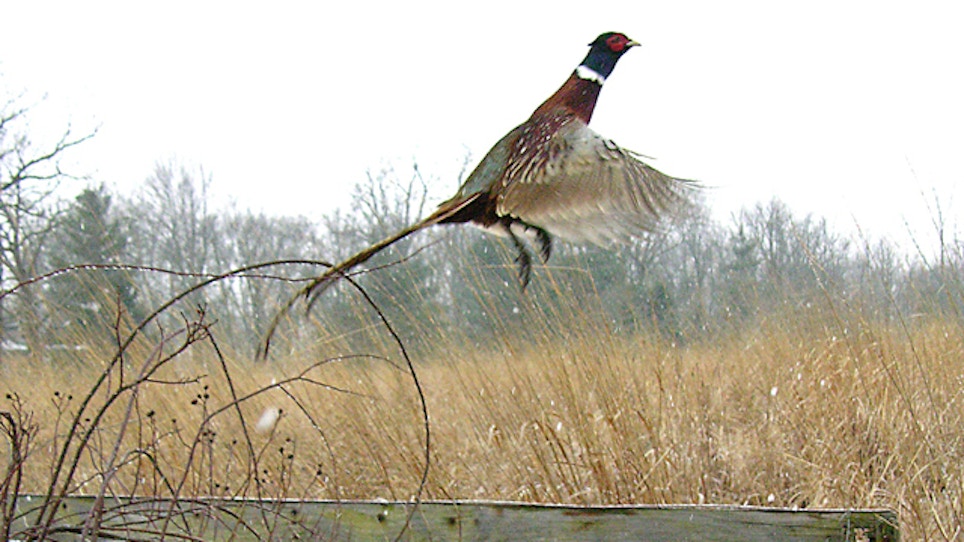By TESSA SCHWEIGERT | Powell Tribune
COWLEY, Wyo. (AP) — In a corner of Cowley dwells a flock of entirely unique pheasants.
Unlike their wild counterparts sought by hunters this season, the birds belonging to ElRay Bridges aren't commonly found in Wyoming, or America, for that matter.
Bridges raises ornamental pheasants, known to be exotic and exquisite.
"There is a market for ornamentals, but I raise them as a hobby," Bridges said.
Bridges currently has 13 varieties of pheasants, but over the years has raised around 24 varieties.
As he walks through the birds' enclosures, it's clear Bridges cares for each bird and knows special characteristics that make it unique. In addition to their brightly colored feathers or different sounds, "they all have their own personalities," Bridges said.
He started raising pheasants while living in Utah years ago, where he belonged to the Utah Pheasant Society. Bridges and his wife, Ann, later moved to Wyoming, and worked at the UW Extension research farm in Powell for 15 years. He returned to the hobby of raising pheasants about 10 years ago.
"After I retired, I decided to get back into it," he said. "I got a pair here and a pair there, and it kept building."
Bridges keeps a male and female of each variety housed in their own enclosures.
Duller in color, the hens look like common birds you might see pecking in a local field. The males are far from ordinary.
Bright cherry red and banana yellow feathers make the red golden pheasant look more like a tropical parrot than a typical pheasant.
"The red golden pheasant is among the most colorful and attractive of all the world's birds," reads a description of the bird on the website Purely Poultry.
Hardy by nature and stunning in appearance, red golden pheasants are raised throughout the world, according to the site.
Other ornamental pheasants' coloring is more subtle, but no less stunning.
Many colors come alive in the sun.
Take the lineated Kalij pheasant, for example.
"He looks black until the sun hits him, and then he's blue," Bridges said of the pheasant commonly found in the Himalayan foothills.
Also brilliantly colored, the Impeyan is larger and one of Bridges' favorites.
"They're friendlier, that's their nature," he said.
The Reeves's pheasant is another favorite. Golden in color with black markings in a lace-like pattern, the Reeves's pheasants are famous for their unusually long tail feathers. Bridges said the male bird's tail can be 5 feet long or more. At 8 years old, the pheasant is one of his older birds.
Some of the pheasants, including the yellow golden and lady amherst, have a cape or ruff, feathers they spread out in display.
"They can turn them around like a fan when sporting a female," Bridges said.
One the rarest birds he's raising is the ijimae copper pheasant.
"There aren't an awful lot of them around the country," he said.
Among the unusual varieties, Bridges also raises Chinese ringneck pheasants. That's the variety living wild in Wyoming. Hunting season for the birds opened earlier this month.
Like the ornamental pheasants Bridges raises, Chinese ringnecks are native to Asia. While common, they certainly aren't plain.
"When it comes to color and variety, the ringnecks are some of the prettiest birds," Bridges said. "They're quite colorful."
Chinese ringneck pheasants were first successfully introduced to America in 1881, when a U.S. consul to China shipped 30 pheasants to his home in Oregon, according to the organization Pheasants Forever. Oregon hosted its first pheasant hunting season 11 years later.
Bridges raises jumbo Chinese ringneck pheasants as well. Just as their name implies, they're bigger birds.
"They're bred for the size," Bridges said. He noted that they're slower and not as vigorous as their smaller counterparts.
Bridges sold ringneck pheasants as game birds at one time, but hasn't in four or five years. He has incubators and raised some young ornamentals, but encountered some issues.
"Neighbors' dogs and raccoons have been the biggest problem," he said.
Bridges has reinforced the enclosures to ensure safety for the birds, and he also keeps a close eye on them.
Bridges has welcomed families, friends and school groups to see the unique pheasants.
He added that it's always been a hobby, "not a money-making project."
"I've enjoyed it over the years," Bridges said.
———
Information from: Powell (Wyo.) Tribune, www.powelltribune.com






